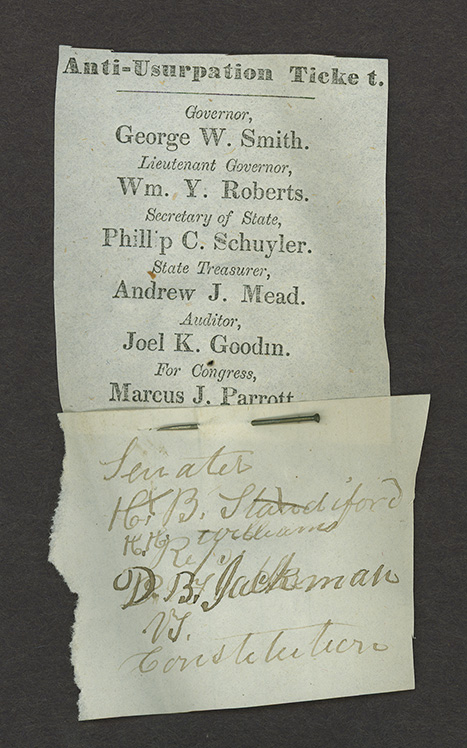By Zach Garrison, University of Cincinnati
Constitution summary:
- Date originally drafted: September 1857
- Stance on slavery: protected
- Suffrage for women: none
- Suffrage for African Americans: none
- Suffrage for Native Americans: none
- Status: rejected by Kansas voters on January 4, 1858
As Kansas Territory marched toward statehood following the Kansas-Nebraska Act of 1854, its citizens, deeply divided along pro- and antislavery lines, rushed to construct a viable state constitution. Four constitutions were eventually proposed, with the second and most controversial emerging from a territorial convention held in Lecompton in 1857, in which the delegates intended to protect the institution of slavery.
After the passage of the Kansas-Nebraska Act and implementation of popular sovereignty in 1854, Kansas Territory was flooded with ideologically inspired Northern and Southern migrants, who hoped to shape the future of the West. The diametrically opposed Free-State and proslavery factions quickly moved to define the path to statehood through legislative conventions where state constitutions could be constructed.
An 1855 election—characterized by voter fraud on the part of proslavery Missourians who crossed the border to cast their ballots—resulted in a largely proslavery territorial legislature based at Lecompton. Free-Staters, including those led by the fiery former Indiana Congressman James H. Lane, initiated their own convention in Topeka, ultimately offering the first proposed constitution in December 1855, which would have effectively banned slavery in Kansas.
Kansas Territory was flooded with ideologically inspired Northern and Southern migrants, who hoped to shape the future of the West.
Despite the fraudulent voting practices that enabled the Lecompton legislature, President Franklin Pierce supported Lecompton and denounced the Topeka Constitution, and the possibility of it receiving federal approval died in the Senate. Still not content, President Pierce declared the Topeka government to be in rebellion. Another blow to the Free-Staters soon followed when in 1856, Charles L. Robinson, who had been elected Territorial Governor at the Topeka convention, was arrested for treason for his role in undermining the Lecompton legislature.
Seizing the moment, a group of predominately slaveholding legislators quickly called for another convention to meet in Lecompton in order to draw up a new constitution that would protect the rights of slave owners and refute the Topeka Constitution. This time, on December 21, 1857, it was the Free-Staters’ turn to boycott, and this, combined with illegal voting practices at the polls including voter intimidation carried out by proslavery Missourians, allowed the proslavery document to pass easily. In addition to the political wrangling, violence and coercion entered the voting booths.
Excerpt from the Lecompton Constitution: “SECTION 1. The right of property is before and higher than any constitutional sanction, and the right of the owner of a slave to such slave and its increase is the same and as inviolable as the right of the owner of any property whatever.”
Proslavery Missourians, known as bushwhackers or border ruffians, once again crossed the border in an effort to intimidate voters or vote themselves, even as James Lane and his "jayhawkers targeted slave owners in both Kansas and Missouri. The breakdown of popular sovereignty and proliferating violence soon caused onlookers to lament “Bleeding Kansas” as an ominous sign of things to come.
Despite the suspicious voting practices that enabled the Lecompton Constitution, President James Buchanan, a pro-Southern Democrat like his predecessor, ultimately endorsed the document. Buchanan’s support was met with outrage among Northern Democrats (including the Illinois senator and architect of the Kansas-Nebraska Act, Stephen Douglas), and the sectional divide laid bare by the debate over Kansas and Lecompton would ultimately split the national Democratic Party in the 1860 presidential election. Meanwhile, the mounting division among Democrats allowed the Free-Staters in Kansas, with the support of the budding Republican Party, to expose the voter fraud behind Lecompton and force a new referendum.
In the next round of voting, on January 4, 1858, Kansas voters rejected the Lecompton Constitution by a decisive margin of 10,226 to 138, suggesting that Free-State supporters overwhelmingly outnumbered the proslavery element and that Lecompton’s previous popularity at the polls was the product of nefarious voting practices. It would take two more attempts, but in July 1859, the similar antislavery Wyandotte Constitution was approved, and Kansas entered the Union as a Free State in early 1861.
Suggested Reading:
Etcheson, Nicole. Bleeding Kansas: Contested Liberty in the Civil War Era. Lawrence: University Press of Kansas, 2004.
Cite This Page:
Garrison, Zach. "Lecompton Constitution" Civil War on the Western Border: The Missouri-Kansas Conflict, 1854-1865. The Kansas City Public Library. Accessed Friday, April 26, 2024 - 01:09 at https://civilwaronthewesternborder.org/encyclopedia/lecompton-constitution


